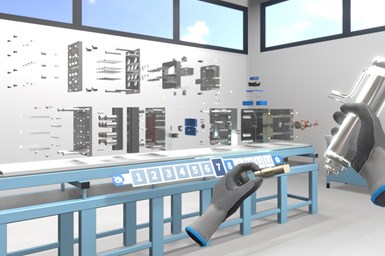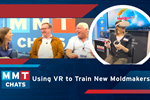Thoughts on VR's Immersive, Interactive Mold Design Training
A virtual reality (VR) application transforms training from passive to active learning by immersing users in a dynamic virtual space.

Utilizing the immersive potential of VR enhances the skills of individual engineers and greatly contributes to the advancement of mold design and manufacturing.
Source: Kruse Analysis and Training
When it comes to mold design and injection molding, precision, speed, and innovation are vital, so there's a continual quest to close the skills gap and usher in a new era of skilled engineers.
With this challenge in mind, an initiative is underway to introduce a virtual reality (VR) application aimed at attracting and cultivating a highly proficient engineering workforce through the power of immersive training.
VR harnesses the latest technology to provide an interactive and compelling learning journey. Future releases will simulate authentic molding scenarios allowing learners to dive hands-on into mold design and production, sidestepping the risks and costs associated with physical experimentation. This training methodology is particularly beneficial when it comes to moldmaking’s nonnegotiable precision and quality.
The transition to VR-based training marks a significant paradigm shift in the instruction of technical skills. Unlike the traditional engineering education model, which emphasizes theoretical knowledge and passive learning, this VR tool plunges learners into a dynamic virtual space. Here, they can engage with three-dimensional models and instantly observe their decisions on mold design. This active learning strategy deepens the understanding of intricate concepts and sharpens problem-solving capabilities.
In today's fast-paced, technology-centric world, learning swiftly and adapting is invaluable. Moldmaking, with its relentless drive for innovation and efficiency, is no exception. The integration of VR into the eLearning framework directly tackles the pressing need for adept engineers, readying the workforce for imminent technological shifts. VR is a magnet for young talent, merging cutting-edge technology with practical experience in a way that resonates with the digital-native demographic.
Also, the application's scalability and ease of access make it a perfect fit for companies eager to enhance their training initiatives without hefty investments. Especially beneficial for small to medium-sized companies, it levels the competitive playing field, enabling them to offer premier training resources to their teams.
Leveraging VR's immersive potential elevates individual engineers' competencies and contributes significantly to the evolution of mold design and manufacturing.
Related Content
-
Confronting the Mold Design Talent Drought
Recently, I reposted on LinkedIn the results of an informal survey we conducted, which revealed a shortage of skilled mold designers. It quickly gained a lot of traction. Given the response, I thought I'd summarize the feedback and keep the conversation going.
-
Unique Mold Design Apprenticeship Using Untapped Resources
To help fill his mold design skills gap, Jeff Mertz of Anova Innovations, is focused on high schools and underprivileged school districts, a school that has lower graduation and college entrance rates. The goal is a student-run enterprise.
-
Hands-on Workshop Teaches Mold Maintenance Process
Intensive workshop teaches the process of mold maintenance to help put an end to the firefighting culture of many toolrooms.















